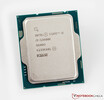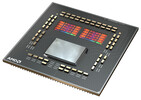Intel Core i5-13600K vs AMD Ryzen 9 5950X vs AMD Ryzen 5 5600X
Intel Core i5-13600K
► remove from comparison
The Intel Core i5-13600K is a fast mid-range desktop processor of the Raptor Lake series. It includes a hybrid architecture for the CPU cores with combined 14 cores. Six fast Raptor Cove performance cores (P-cores) with HyperThreading and a clock speed of 3.5 - 5.1 GHz and eight Gracemont efficiency cores without HyperThreading and a clock speed of 2.6 - 3.9 GHz.
Thanks to the faster P-cores and more E-cores, the i5-13600K is significantly faster than the old i5-12600K (especially in multi-threaded workloads.
The 13600K is rated at 125 Watt TDP base power (PL1) and 181 Watt Turbo Power (PL2) and therefore slightly higher than the old Core i5-12600K.
AMD Ryzen 9 5950X
► remove from comparison
The AMD Ryzen 9 5950X is a high-end 16-core, hyperthreaded (SMT) Vermeer Series desktop processor. With 32 threads, the new flagship offers as many threads as the AMD Ryzen 9 3950X. Introduced on October 8, 2020, the Ryzen 9 5950X is the fastest 16-core processor and is specified at 105 watts TDP.
The Ryzen 9 5950X runs at 3.4 GHz to 4.9 GHz (single core). Wen all 16 cores are loaded, up to 4.5 GHz are still possible.
The internal structure of the processor has not changed fundamentally at first glance. The CCX structure has changed a bit compared to Zen 2, because now a CCX consists of up to 8 CPU cores. So each individual core can access the complete L3 cache (32 MByte). Furthermore the CCX modules are connected to each other via the same I/O die, which we already know from Zen2. According to AMD, the Infinity fabric should now reach clock rates of up to 2 Ghz, which in turn allows a RAM clock of 4,000 MHz without performance loss.
Performance
The average 5950X in our database matches the Core i9-12900K, the Core i9-12900HX and also the Ryzen Threadripper 2970WX in multi-thread performance, making this Ryzen a great processor for pretty much any task imaginable as of mid 2022.
Power consumption
This Ryzen 9 series chip has a default TDP (also known as the long-term power limit) of 105 W. It will, however, happily consume much more than that as long as the cooling solution is able to handle the heat - even before one starts considering the possibility of overclocking the thing.
The Ryzen 9 5950X is built with TSMC's 7 nm process for average, as of mid 2023, energy efficiency.
AMD Ryzen 5 5600X
► remove from comparison
The AMD Ryzen 5 5600X is a desktop processor with 6 SMT-enabled (12 threads) and based on the Zen 3 architecture. Launched in November 2020, it is the fastest 6-core Ryzen desktop processor. With a TDP of 65 watts, the Ryzen 5 5600X is the least energy-hungry model in the Zen 3 family to date.
The Ryzen 5 5600X is clocked at 3.7 GHz base clock and can be clocked up to 4.6 GHz with Precision Boost 2.
Performance
The average 5600X in our database is in the same league as the Ryzen 9 4900H and the Ryzen 7 6800HS, as far as multi-thread benchmark scores are concerned. While this isn't the fastest CPU money can buy, it still rips through most workloads with ease, as of mid 2022. Find out more in our full review.
Power consumption
This Ryzen 5 series chip has a default TDP (also known as the long-term power limit) of 65 W to be in line with most desktop processors.
The R5 5600X is built with TSMC's 7 nm process for average, as of early 2023, energy efficiency.
| Model | Intel Core i5-13600K | AMD Ryzen 9 5950X | AMD Ryzen 5 5600X | ||||||||||||||||||||||||||||||||||||||||||||||||||||||||||||||||||||||||
| Codename | Raptor Lake | Vermeer (Zen 3) | Vermeer (Zen 3) | ||||||||||||||||||||||||||||||||||||||||||||||||||||||||||||||||||||||||
| Series | Intel Raptor Lake-S | AMD Vermeer (Ryzen 5000) | AMD Vermeer (Ryzen 5000) | ||||||||||||||||||||||||||||||||||||||||||||||||||||||||||||||||||||||||
| Series: Vermeer (Ryzen 5000) Vermeer (Zen 3) |
|
|
| ||||||||||||||||||||||||||||||||||||||||||||||||||||||||||||||||||||||||
| Clock | 3500 - 5100 MHz | 3400 - 4900 MHz | 3700 - 4600 MHz | ||||||||||||||||||||||||||||||||||||||||||||||||||||||||||||||||||||||||
| L2 Cache | 20 MB | 8 MB | 3 MB | ||||||||||||||||||||||||||||||||||||||||||||||||||||||||||||||||||||||||
| L3 Cache | 24 MB | 64 MB | 32 MB | ||||||||||||||||||||||||||||||||||||||||||||||||||||||||||||||||||||||||
| Cores / Threads | 14 / 20 6 x 5.1 GHz Intel Raptor Cove P-Core 8 x 3.9 GHz Intel Gracemont E-Core | 16 / 32 | 6 / 12 | ||||||||||||||||||||||||||||||||||||||||||||||||||||||||||||||||||||||||
| TDP | 125 Watt | 105 Watt | 65 Watt | ||||||||||||||||||||||||||||||||||||||||||||||||||||||||||||||||||||||||
| Technology | 10 nm | 7 nm | 7 nm | ||||||||||||||||||||||||||||||||||||||||||||||||||||||||||||||||||||||||
| Die Size | 257 mm2 | CPU cores: 2x 80.7 sq. mm., I/O: 125 mm2 | |||||||||||||||||||||||||||||||||||||||||||||||||||||||||||||||||||||||||
| max. Temp. | 100 °C | 95 °C | |||||||||||||||||||||||||||||||||||||||||||||||||||||||||||||||||||||||||
| Socket | LGA 1700 | AM4 | AM4 | ||||||||||||||||||||||||||||||||||||||||||||||||||||||||||||||||||||||||
| Features | Intel UHD Graphics 770, DDR5 5600 MT/s, DDR4 3200 MT/s | DDR4-3200 RAM, PCIe 4, MMX (+), SSE, SSE2, SSE3, SSSE3, SSE4.1, SSE4.2, SSE4A, AES, AVX, AVX2, FMA3, SHA | DDR4-3200 RAM, PCIe 4, MMX (+), SSE, SSE2, SSE3, SSSE3, SSE4.1, SSE4.2, SSE4A, AES, AVX, AVX2, FMA3, SHA | ||||||||||||||||||||||||||||||||||||||||||||||||||||||||||||||||||||||||
| iGPU | Intel UHD Graphics 770 (300 - 1500 MHz) | ||||||||||||||||||||||||||||||||||||||||||||||||||||||||||||||||||||||||||
| Architecture | x86 | x86 | x86 | ||||||||||||||||||||||||||||||||||||||||||||||||||||||||||||||||||||||||
| $319 U.S. | $799 U.S. | $299 U.S. | |||||||||||||||||||||||||||||||||||||||||||||||||||||||||||||||||||||||||
| Announced | |||||||||||||||||||||||||||||||||||||||||||||||||||||||||||||||||||||||||||
| Manufacturer | www.intel.com | www.amd.com | www.amd.com | ||||||||||||||||||||||||||||||||||||||||||||||||||||||||||||||||||||||||
| L1 Cache | 1 MB | 384 KB |
Benchmarks
Average Benchmarks Intel Core i5-13600K → 100% n=46
Average Benchmarks AMD Ryzen 9 5950X → 100% n=46
Average Benchmarks AMD Ryzen 5 5600X → 74% n=46
* Smaller numbers mean a higher performance
1 This benchmark is not used for the average calculation












